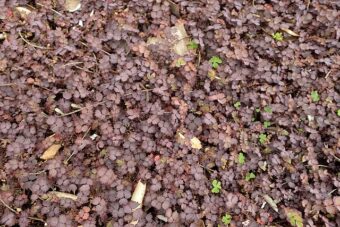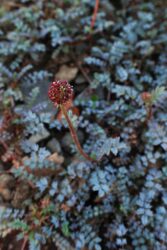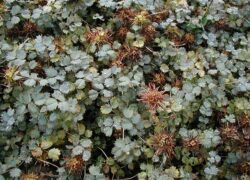In this article, we will be discussing how to grow the creeping herbaceous evergreen perennial plant of Acaena in containers. It is actually a member of the rose family with 60 species being known but certainly, it does not look like one. It is native to New Zealand, Australia and South America with only a few species growing in the northern hemisphere.
Acaena is a low growing perennial that is great for covering cracks between paving slab stones and providing ground cover between plants or cascading over the edges of containers.

The leaves tend to be small or large, from 4 to 15cm in length. They are also often pinnate and have many leaflets. In some species, the leaves can be colourful whilst in others not so much. It only grows up to 7.5cm in height, but in many species, it is not grown for the leaves or the flower that are produced but for the seed heads it produces in late summer. The globe-shaped flowers tend to be 1 to 2cm in diameter and unusually has no petals.
THE FLOWERS ARE PRODUCED IN AUGUST
In August, the flowers turn into a dense ball of seeds that have burrs on them that are often brightly coloured. The colourful seed heads are the reasons why this perennial is grown, The burrs often stick to animal firs, clothing or bird feathers where the seeds are carried and dispersed to spread themselves.
Find out how to grow this perennial or sub-shrub in containers in this article.
HOW TO GROW ACAENA IN CONTAINERS
Although you can grow Acaena from seed this is not the norm, but it is better to buy garden-ready plants.

First, choose a container that is within the dimensions of the plant and will suit its surroundings. No matter what container you choose, make sure it has plenty of drainage holes. To this add a 1cm layer of gravel and on top of this, add a mixture of 80% by volume multipurpose compost with 20% by volume horticultural grit.
This is very important as the compost must be free-draining. The great thing about Acaena is that they do well in poor soils so you do not need to feed often.
To the compost, dig a hole that is slightly bigger than the root ball it came in the original container. Place the plant in so that the top of the root ball is at the same level as the top surface of the compost. Backfill with the growing media, ensuring that any gaps that remain are filled with more compost. Firm the plant in and water well.
PLACE IN A WELL LIT AREA
Place it in an area where it either gets full sun or in partial shade. It does not matter either way. You will need to water well until it is well established, but no matter what, water when 5cm below the top surface of the compost feels dry to the touch. This means water frequently in hot, sunny weather.

As they tolerate poor soil, I would not feed unless the plant is clearly showing signs of lacking nutrients. You can give in spring an annual dressing of fish, blood and bone or growmore to get it through the growing season.
The plant in the ground will spread rapidly but in containers, the plant will be more constrained. If the plant gets congested, you can divide the plant into equal divisions for planting in individual pots. This can be done in autumn or spring.
PESTS AND DISEASES
In terms of pests and diseases, the plant does not readily suffer from any. If you are unlucky, you may get some powdery mildew or rust, both fungal diseases. You can use a broad-spectrum fungicide to treat these diseases if you observe them at their early stages or if powdery mildew has been a problem in the past. You can improve air circulation around the plant and make sure that the plant is not dry at the roots.
VARIETIES TO GROW

You will find a few genera on sale in the UK, but the following are recommended:
Acaena inermis ‘Purpurea’ (Spineless Acaena) is a spreading perennial with tiny rose-like purple leaves that are coated with a faint grey bloom. On top of these clusters of tiny white flowers appear in July and August.
Acaena saccaticupula ‘Blue Haze’ is another mat-forming plant with finely cut leaves of pewter that is tinged mauve and produced on bronze stems. The red flowers are produced in July and August.
Acaena affinis is a mat-forming perennial with filigree, blue-grey leaves with contrasting red stems. In July and August red flowers are produced in large numbers.
Acaena buchananii is a mat-forming perennial that has finely feathered, blue-green evergreen leaves. On top of these leaves, rusty red burred flower heads appear in summer.
Acaena microphylla is the common one to grow. It is an evergreen perennial with small, pinnate leaves that are tinged bronze whilst young. On top of these white globular flowers appear that are followed with seed heads with reddish burrs. This gives the plant its classical look. A noted variety to grow is ‘Kupferteppich/Copper Carpet’.
CONCLUSIONS
In this article, we have discussed how to grow the wonderful colourful plant of Acaena on containers. A plant that is grown for its colourful leaves and burr seed heads that will give much beauty to a container garden.
They are easy to grow, easy to look after and beautiful to look after, so what is not to enjoy in the container garden.
If you have any questions or comments that you wish to make on growing Acaena in containers, please do so in the comment box below.
Happy Acaena growing.
